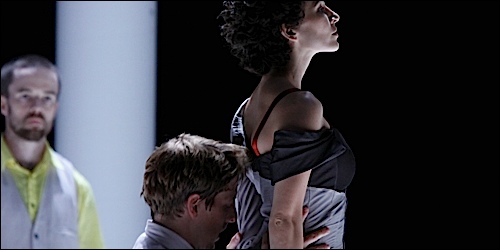
Paul Matteson and Asli Bulbul in "Fondly Do We Hope … Fervently Do We Pray" (Photo: Paul B. Goode).
Bill T. Jones will live to see 150. That's what the dancer-turned-director tells himself, anyway. It's a credo that's helped him defy aging, as the HIV he's had since the '80s – and his body, which began dancing formally at the unusually late age of 19 – tries to tell him otherwise.
He can't move like a teenager anymore, though, and so he feeds dancers with still-gummy bodies the direction to do so. In "Fondly Do We Hope … Fervently Do We Pray," inspired by Abraham Lincoln's legacy and set for performances Jan. 22-23 at Ann Arbor's Power Center, that dexterity is showcased. Not by Jones, though, who won't be fervently whipping his legs around in passionate swooshes. His last performance before retiring was at the Louvre in Paris two years ago. Or so he said. Lately, the inner performer in Jones is demanding some attention. Body, be damned.
"The performer's asking the director, 'Can you make something that will take into consideration my 57-year-old body with my bad knees and lower back, that has less stamina than it used to?'" says Jones, who's spent the last 28 years choreographing some of the most button-pushing pieces under his production company, the Bill T. Jones/Arnie Zane Dance Company.
After AIDS took his partner Arnie Zane in the late '80s, he tackled the epidemic in 1994's "Still/Here" with controversial chutzpah, dressing dancers in red blood platelet-looking costumes.
These days, Jones doesn't care to instigate a fuss. "I leave that to the younger generation," he laughs; the tone of his voice – and the initial gasp-then-laugh – offers an "I'm-too-old-for-that-shit" exclamation without him giving it. With
"Fondly," he's focused on the historical relevance and the absorbing emotional aspects of Lincoln's life, as it celebrates in on the legendary leader's bicentennial.
It almost didn't happen. Thinking of it as a mere black history piece, Jones just about passed on the project – until he tore through three varied, historically-thick books that piqued his interest. "I was so excited about my research, my rediscovery of Abraham Lincoln," he gushes.
Then he thought of the modern-day parallels, how nearly every president pretends he's Lincoln, ready to uphold values and make tough choices and mimic his indelible attitude.
"He is the everyman and what Americans like to pride themselves on being – this honest individual with the highest morality," he says.
Jones, having grown up during the peak of the Civil Rights struggle, recalls his history-conscious schooling, when he had to memorize the Gettysburg Address. An experiment performed at the Yerba Buena Center for the Arts in San Francisco to test the average person's knowledge of Lincoln revealed that not everyone is well-versed in history. One person thought he became president in 1916.
"The answers were astoundingly ignorant," Jones recalls. "I thought that this work might be able to just jog people's memories."
And make them feel something with a very modernistic approach, one that's geared toward the Web world and TV watchers. Images are clean and crisp and sometimes connected with spoken word, and contemporary and historical sound bytes accompany the sophisticated sights.
This is the way Jones sees dance – as art, provoking and asking questions. Not as a hip reality-show contest trying to drive television ratings, like "So You Think You Can Dance" or "Dancing With the Stars."
"I don't think I'm of the same planet," he laughs. "I don't think dance is a sport. It should be something more ritualized and much more introspective if it's going to be dance. Having said that, I am really wrestling right now with understanding how the dance that I make will be absorbed by mass culture.
"I'm thinking a lot about what's next for my company and what's next for me in that regard, because I'm not really so interested in being in the ivory tower or the art ghetto of the avant-garde, which produced me and cut my teeth. I'm a little tired of it right now, actually."
All the more reason for him to unleash the caged dancer. Sometimes it escapes; at parties, he'll spontaneously slide a seat in and take center stage.
When Jones thinks of that resurfaced desire, he remembers a joke about Melissa Hayden, a glorious New York City ballet dancer in the '60s: how she loved dancing so much that someone would have to yank her off stage and chain her down.
He laughs as he tells the story. "I'm not that shameless."
'Fondly Do We Hope…Fervently Do We Pray'
8 p.m. Jan. 22 and 23, Power Center
121 Fletcher Street, Ann Arbor
$18-$44
http://www.ums.org
Bill T. Jones will also speak as part of the Penny W. Stamps Series: A Question of Strategy and Objectives from 5:10-7 p.m. Jan. 21 at the Michigan Theater (603 E. Liberty Street, Ann Arbor).










